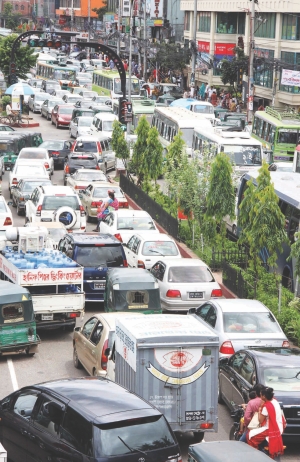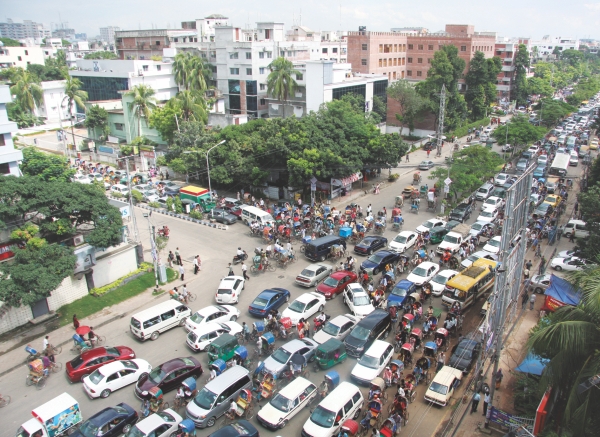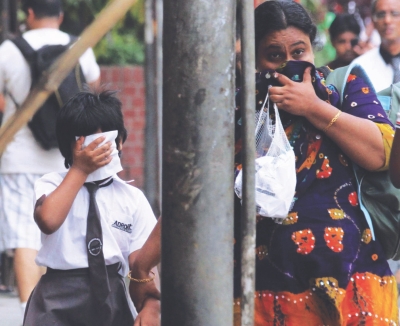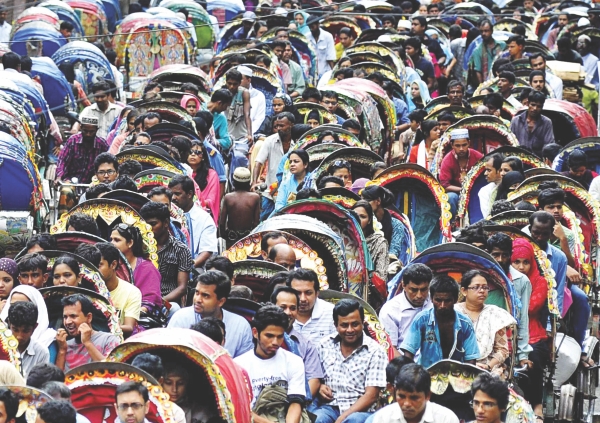| Home - Back Issues - The Team - Contact Us |
 |
| Volume 11 |Issue 41| October 19, 2012 | |
|
|
City Changing Dhanmondi M Zahir Hasssan Nabil
Etymologically speaking, the word 'Dhanmondi' evolved from the vast grazing lands the place once had for cultivating and trading Dhan (paddy). But the area's evolution just did not follow a straight course of 'development'. It swerved defiantly over the years, giving rise to a cacophonous and traffic-choked fragment of the capital. Today's Dhanmondi is where commercial establishments vie with the residential, albeit enjoying 'residential' status in its early days in the 60s. People in the area hold responsible issues such as multiplying vehicles, insufficient roads, growing educational and business establishments, insufficient parking facilities for the aggravating traffic congestion and the declining tranquility in the 'residential area'. “When Dhanmondi boasted smaller houses surrounded by trees, a family of 10 members was allotted around 7,200 square feet which is now occupied by 19 to 20 families, living in at least a six-storey building”, says Khan Abdul Bari, a former Public Works Department (PWD) official. New high-rise buildings have begun to peek out amid the six-storeys as the previous height-capping has been relaxed recently. Well, now people have to accommodate. The neighbourhood's facelift seems good enough along the paradigm of 'development' but this is clearly mutually exclusive with the serenity of the former Dhanmondi. “Dhanmondi is a failure of our urban planners and policymakers. Had they planned it foresightedly when it emerged, it would not have become a miscarriage of poor planning as it is today,” says journalist Morshed Ali Khan, a Dhanmondi resident for about 50 years. That was just about accommodation. On the other hand, people must have free roads to smoothly move through, in and out of the area. But vehicular movement decelerates particularly on the quadrangular frame consisting of the Satmasjid road, roads 2 and 27 (old) and the Mirpur road along Dhanmondi. This happens because the busy intersections on the frame ooze with transports particularly during the office hours and while commuting for schools, universities. “The suffix R/A should be stripped off from Dhanmondi immediately, it's farcical,” says Zakia Sultana, a teacher who gets stuck at least twice a day while fetching her daughter from school.
The roads are neither multiplying nor widening like those should have been, apart from some repairs for footpaths and the ones in complete tatters. The streets have a capacity called “road to vehicle ratio' which indicates how many vehicles a road can sustain while keeping the flow reasonably well. In this regard, the thoroughfares and busy crossroads are clearly overburdened beyond their capabilities. “About 10 years ago, the average speed of vehicles on Dhaka thoroughfares was 17 kms an hour, it has surely decreased due to congestion and the increasing number of vehicles,” says Mostadar Rahman, a senior structural engineer at Local Government Engineering Department (LGED). As for clogging down the traffic, the credit goes to the planners who allowed it to happen. Asked whether one of the famous food outlets in Dhanmondi is affecting the congestion, its manager, on anonymity, replied affirmatively, “The customers cannot park on the main road in the fear of getting a police case and therefore, occupy the nearby streets, causing those to narrow down.” He admits the congestion is unbearable these days.
Similarly, when asked what would happen when traffic congestion increases in the years to come for more people swarming to the corners, the manager of another famous food outlet on the Satmasjid road honestly admits, “I don't care; this will bring me more customers”. Adding to this, the business establishments are taking full advantage of the traffic congestion by putting up their advertisements on billboards around the intersections, forcing the cityscape to change as well. The 'visual congestion', a vile counterpart of road congestion, is delimiting people's line of sight and impeding the respite to thoughts one may have when stuck in traffic. In contrast, even five years ago, billboards were quite unpopular and less frequent in the entire capital. It seems the traffic knot is ever more complex and simply inescapable. The enormity of financial loss from traffic congestion across the city is quite difficult to imagine. Two years ago, a Roads and Highways (R&H) study titled “Traffic congestion in Dhaka and its impact on business: Some remedial measures” indicated that the congestion eats up Tk 19,555 crore every year, out of which wasted time on the streets accounts for nearly Tk 11,896 crore. This figures implied that more than Tk. 3,772 disappeared every second people were stuck in traffic in 2010. Undoubtedly the figures have increased in 2012.
In the country people have rickshaws as an alternative to walking, car owners can easily afford drivers and the public transport is miserable. Despite the traffic gridlock every day, people hardly walk; they do not walk or cannot walk the actual cause is difficult to determine. Seemingly, it is preferable for some people to languish inside the car or on rickshaws for an hour instead of taking a few minutes' quick walk from one block to another. Multiplying vehicles on the roads and the rickshaws swaying in between have become a trial of patience for long, with the entire scene becoming a still photograph several times a day. And a resolution for the irritating traffic gridlock is quite uncertain, with the growing numbers of vehicles, people, business establishments and of course the new high-storeys. Serene Dhanmondi R/A remain only in the collective memory of our elders. The writer is a reporter at TDS Online.
|
||||||||
Copyright
(R) thedailystar.net 2012 |



